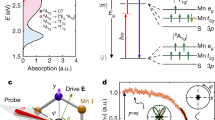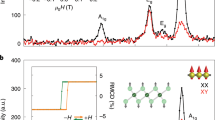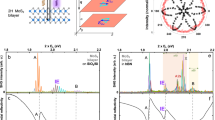Abstract
Electrical modulation of nonlinear optical signals is crucial for emerging applications in communications and photonic circuits. However, current methods of modulating the second-order optical susceptibility involve indirectly and inefficiently changing the third-order susceptibility. Here we show that electrical switching of the crystal structure of monolayer molybdenum ditelluride can be used to directly modulate the second-order susceptibility. This approach leads to modulation of the second-harmonic generation with an on/off ratio of 1,000 and modulation strength of 30,000% per volt, as well as broadband operation of 300 nm. We also show that molybdenum ditelluride bilayers exhibit opposite modulation trends due to electrically induced heterostructures.
This is a preview of subscription content, access via your institution
Access options
Access Nature and 54 other Nature Portfolio journals
Get Nature+, our best-value online-access subscription
$29.99 / 30 days
cancel any time
Subscribe to this journal
Receive 12 digital issues and online access to articles
$119.00 per year
only $9.92 per issue
Buy this article
- Purchase on Springer Link
- Instant access to full article PDF
Prices may be subject to local taxes which are calculated during checkout




Similar content being viewed by others
Data availability
The data that support the findings of this study are available from the corresponding author upon reasonable request.
References
Cai, W., Vasudev, A. P. & Brongersma, M. L. Electrically controlled nonlinear generation of light with plasmonics. Science 333, 1720–1723 (2011).
Smith, S. D. Lasers, nonlinear optics and optical computers. Nature 316, 319–324 (1985).
Boyd, R. W. & Prato, D. Nonlinear Optics (Elsevier Science, 2008).
Paesani, S. et al. Generation and sampling of quantum states of light in a silicon chip. Nat. Phys. 15, 925–929 (2019).
Caspani, L. et al. Integrated sources of photon quantum states based on nonlinear optics. Light Sci. Appl. 6, e17100 (2017).
Woods, D. & Naughton, T. J. Photonic neural networks. Nat. Phys. 8, 257–259 (2012).
Terhune, R. W., Maker, P. D. & Savage, C. M. Optical harmonic generation in calcite. Phys. Rev. Lett. 8, 404–406 (1962).
Kang, L. et al. Electrifying photonic metamaterials for tunable nonlinear optics. Nat. Commun. 5, 4680 (2014).
Kumar, N. et al. Second harmonic microscopy of monolayer MoS2. Phys. Rev. B 87, 161403 (2013).
Song, Y. et al. Second harmonic generation in atomically thin MoTe2. Adv. Opt. Mater. 6, 1701334 (2018).
Wen, X., Gong, Z. & Li, D. Nonlinear optics of two‐dimensional transition metal dichalcogenides. InfoMat 1, 317–337 (2019).
Zhao, M. et al. Atomically phase-matched second-harmonic generation in a 2D crystal. Light Sci. Appl. 5, e16131 (2016).
Ye, Z. et al. Probing excitonic dark states in single-layer tungsten disulfide. Nature 513, 214–218 (2014).
Chernikov, A. et al. Exciton binding energy and nonhydrogenic Rydberg series in monolayer WS2. Phys. Rev. Lett. 113, 076802 (2014).
Ye, J. T. et al. Superconducting dome in a gate-tuned band insulator. Science 338, 1193–1196 (2012).
Chernikov, A., Ruppert, C., Hill, H. M., Rigosi, A. F. & Heinz, T. F. Population inversion and giant bandgap renormalization in atomically thin WS2 layers. Nat. Photon. 9, 466–470 (2015).
Li, Y., Duerloo, K.-A. N., Wauson, K. & Reed, E. J. Structural semiconductor-to-semimetal phase transition in two-dimensional materials induced by electrostatic gating. Nat. Commun. 7, 10671 (2016).
Wang, Y. et al. Structural phase transition in monolayer MoTe2 driven by electrostatic doping. Nature 550, 487–491 (2017).
Chen, S., Li, K. F., Li, G., Cheah, K. W. & Zhang, S. Gigantic electric-field-induced second harmonic generation from an organic conjugated polymer enhanced by a band-edge effect. Light Sci. Appl. 8, 17 (2019).
Ren, M. L., Berger, J. S., Liu, W., Liu, G. & Agarwal, R. Strong modulation of second-harmonic generation with very large contrast in semiconducting CdS via high-field domain. Nat. Commun. 9, 186 (2018).
Seyler, K. L. et al. Electrical control of second-harmonic generation in a WSe2 monolayer transistor. Nat. Nanotechnol. 10, 407–411 (2015).
Simon, P. & Gogotsi, Y. Materials for electrochemical capacitors. Nat. Mater. 7, 845–854 (2008).
Ruppert, C., Aslan, B. & Heinz, T. F. Optical properties and band gap of single- and few-layer MoTe2 crystals. Nano Lett. 14, 6231–6236 (2014).
Liu, A., Gleason, K. K. & Wang, M. Vapor-deposited nanoscale ionic liquid gels as gate insulators for low-voltage high-speed thin film transistors. US patent 10,510,971 (2019).
Moon, H. et al. Synthesis of ultrathin polymer insulating layers by initiated chemical vapour deposition for low-power soft electronics. Nat. Mater. 14, 628–635 (2015).
Malard, L. M., Alencar, T. V., Barboza, A. P. M., Mak, K. F. & de Paula, A. M. Observation of intense second harmonic generation from MoS2 atomic crystals. Phys. Rev. B 87, 201401(R) (2013).
Li, Y. et al. Probing symmetry properties of few-layer MoS2 and h-BN by optical second-harmonic generation. Nano Lett. 13, 3329–3333 (2013).
Yu, H., Talukdar, D., Xu, W., Khurgin, J. B. & Xiong, Q. Charge-induced second-harmonic generation in bilayer WSe2. Nano Lett. 15, 5653–5657 (2015).
Roldán, R., Cappelluti, E. & Guinea, F. Interactions and superconductivity in heavily doped MoS2. Phys. Rev. B 88, 054515 (2013).
Lu, J. M. et al. Evidence for two-dimensional Ising superconductivity in gated MoS2. Science 350, 1353–1357 (2015).
Ramasubramaniam, A. Large excitonic effects in monolayers of molybdenum and tungsten dichalcogenides. Phys. Rev. B 86, 115409 (2012).
Xu, X. et al. Seeded 2D epitaxy of large-area single-crystal films of the van der Waals semiconductor 2H MoTe2. Science 372, 195–200 (2021).
Liu, F. et al. Disassembling 2D van der Waals crystals into macroscopic monolayers and reassembling into artificial lattices. Science 367, 903–906 (2020).
Shim, J. et al. Controlled crack propagation for atomic precision handling of wafer-scale two-dimensional materials. Science 362, 665–670 (2018).
Wang, X. et al. Realization of vertical metal semiconductor heterostructures via solution phase epitaxy. Nat. Commun. 9, 3611 (2018).
Acknowledgements
This work is supported by the Gordon and Betty Moore Foundation (award no. 5722) and the Ernest S. Kuh Endowed Chair Professorship.
Author information
Authors and Affiliations
Contributions
Y.W. and X.Z. initiated the research and designed the experiments. Y.W. and J.X. performed the SHG measurements. Y.W. and T.-F.C. fabricated the devices. Y.W. J.X., Z.N. and S.Y. analysed the data with X.Z. All the authors contributed to the writing of the manuscript.
Corresponding author
Ethics declarations
Competing interests
The authors declare no competing interests.
Additional information
Peer review information Nature Electronics thanks Ueli Koch, Zheng Liu and Shuang Zhang for their contribution to the peer review of this work.
Publisher’s note Springer Nature remains neutral with regard to jurisdictional claims in published maps and institutional affiliations.
Supplementary information
Supplementary Information
Supplementary Discussion and Figs. 1–8.
Rights and permissions
About this article
Cite this article
Wang, Y., Xiao, J., Chung, TF. et al. Direct electrical modulation of second-order optical susceptibility via phase transitions. Nat Electron 4, 725–730 (2021). https://doi.org/10.1038/s41928-021-00655-0
Received:
Accepted:
Published:
Issue Date:
DOI: https://doi.org/10.1038/s41928-021-00655-0
This article is cited by
-
Broadband nonlinear modulation of incoherent light using a transparent optoelectronic neuron array
Nature Communications (2024)
-
Giant electric field-induced second harmonic generation in polar skyrmions
Nature Communications (2024)
-
Intrinsic 1\({T}^{{\prime} }\) phase induced in atomically thin 2H-MoTe2 by a single terahertz pulse
Nature Communications (2023)



